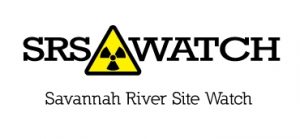 “Given the importance of SWPF and this initial phase of its operation, updates must be frequent and honest by DOE, not delayed and incomplete,” – Tom Clements, director of SRS Watch
“Given the importance of SWPF and this initial phase of its operation, updates must be frequent and honest by DOE, not delayed and incomplete,” – Tom Clements, director of SRS Watch
Columbia, South Carolina – An independent safety board that monitors activities of the U.S. Department of Energy reports a “hard shutdown” during the initial startup of cesium removal from high-level nuclear waste at the Salt Waste Processing Facility (SWPF) at DOE’s Savannah River Site (SRS).
This is the second time that DOE has failed to mention a significant startup problem at SWPF, potentially undermining trust in its reporting to the public on the initial operations of this key facility to process liquid high-level nuclear waste, according to the public interest organization Savannah River Site Watch (SRS Watch). SWPF began “hot commissioning” involving radioactive liquid on October 5, 2020.
Earlier, DOE failed to report a problem with operation of a pump during the SWPF startup and only revealed it after Savannah River Site Watch reported it in a news release on November 9, 2020.
In the Defense Nuclear Facilities Safety Board’s (DNFSB) weekly report for October 23, 2020, the DNFSB resident inspectors reported problems during the operation of the process to remove radioactive cesium from the liquid high-level nuclear waste pumped from the SRS waste storage tanks. The weekly report also mentioned issues with unused pipes and a potential risk of high radiation levels, issues that had also been mentioned to SRS Watch but which remained an unsubstantiated rumor until now. The DNFSB weekly report reveals more matters of concern during startup and not yet admitted by DOE:
Salt Waste Processing Facility (SWPF): Parsons started up the Caustic-Side Solvent Extraction (CSSX) process. During one of the CSSX startups, the process went into a hard shutdown after encountering a drive fault alarm with one of the extraction contactors. A resident inspector (RI) observed a transfer from SWPF to Tank 50 in H-Tank Farm. Prior to the transfer, the control room personnel noted during the pre-job brief that they would begin recording sump level data upon initiation of the transfer and thirty minutes thereafter. However, the procedure directed them to begin recording sump levels fifteen minutes after starting the transfer. Considering that a leak would not be immediately recognizable through the level monitors, it is appropriate that monitoring would not begin immediately after starting the transfer. The RI provided this feedback to SWPF management and noted the importance of procedure compliance.
A RI also observed the Startup Review Board meeting. The results of the shielding verification surveys led Parsons to fill up some empty pipes to reduce radiation streaming and to replace a filter when its whole body dose rate reaches 80 mrem/hr to avoid creating a high radiation area. Parsons approved increasing the feed concentration to 0.2 Ci/gal.
weekly reported linked here
According to belated DOE news release of November 9, cesium removal is the second step in the operations now undergoing startup in SWPF: “The process begins by transferring the waste from H Tank Farm to SWPF where it undergoes a two-step cleanup process….The first step removes strontium and actinides (uranium, plutonium, etc.) from the waste. The second step, known as Caustic Side Solvent Extraction (CSSX), is designed for the removal of radioactive cesium.”
“While issues during the initial operation of SWPF may be expected, it is only through full and accurate reporting on the status of the facility that trust can be built in DOE’s startup effort,” said Tom Clements, director of SRS Watch. “Given the importance of SWPF and this initial phase of its operation, updates must be frequent and honest by DOE, not delayed and incomplete,” added Clements.
Two important documents concerning the status of the delayed SWPF startup include the November 9 news release by SRS Watch and the responsive news release by DOE, issued late in the afternoon of November 9, in which a problem with a pump, as indicated by SRS Watch, was confirmed by DOE:
SRS Watch news release, November 9: Safety Board Confirms Rumors about Problems with Start Up of Salt Waste Processing Facility at Savannah River Site; DOE-SRS Refuses to Provide an Update on Status of the Facility – Why?
DOE-SRS Watch news release, November 9: SALT WASTE PROCESSING FACILITY OPERATIONS UNDER WAY
https://srswatch.org/wp-content/uploads/2020/11/News-Release_SWPF-Update_Nov-9-2020_FINAL-1.pdf
The tardy DOE news release affirms the rumor about problems with at least one pump, as mentioned to SRS Watch, and which DOE would not confirm until November 9 in spite of SRS Watch inquires beginning on October 28. The DOE news release inexplicably avoided mention of the problem with initial CSSX operation: “The SWPF systems and components have largely performed as expected. The only notable issue to date was identified during one of the early transfers, when a pump that sends the salt waste into the CSSX process did not operate properly. The pump has since been replaced.”
